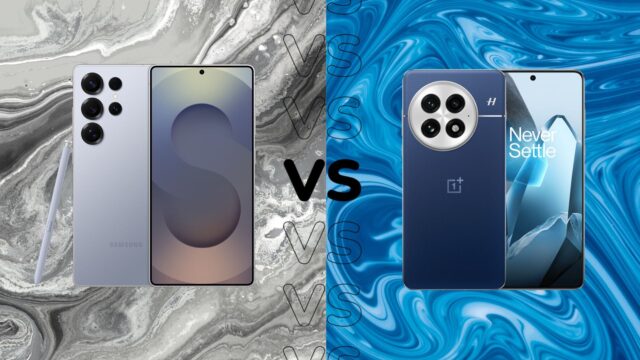The Samsung Galaxy S25 Ultra is here to take on the 2025 flagship market – but how does it compare to one of the first to enter the fray, the OnePlus 13?
While there’s £450/$500 between two of the best smartphones, the two share more similarities than you might first expect – and that could sway your decision on which you should buy.
The OnePlus 13, for example, also offers a similarly pixel-packed QHD+ resolution to the S25 Ultra, while actually leaving it in the dust when it comes to charging. However, the S25 Ultra offers a much more reliable camera experience, while small features like an anti-reflective coating on the screen and the S Pen really help it stand out.
We’ve reviewed both the Samsung Galaxy S25 Ultra and OnePlus 13, and here’s how the two compare in day-to-day use.
Spec comparison
Pricing & availability
The Samsung Galaxy S25 Ultra is a top-end phone with a price tag to match, starting at a not-insignificant £1,249/$1,299 with 256GB of storage, though you can go all the way up to 1TB for £1,549/$1,659 if you need more space.
The OnePlus 13 is also a premium smartphone, but it’s also much more affordable than the top-end Galaxy at £899/$899, with a boosted 512GB available for £999/$999.
Both smartphones are readily available to buy right now, either outright or on contract from carriers.
Design
- Galaxy S25 Ultra has flat edges and rounded corners
- OnePlus 13 is slightly curvier
- OnePlus 13 offers IP68/69 dust and water resistance
The two flagships differ quite wildly in the design department. For starters, the Samsung Galaxy S25 Ultra offers a titanium frame in place of the aluminium frame from the OnePlus 13. However, the OnePlus 13 offers either glass or vegan leather finishes, compared to the glass-only alternative from Samsung’s flagship, so it really is a matter of preference.
Previous Samsung flagships offered a similar curvature to the OnePlus 13, with a slight curve to both the screen and the rear that helps it sit a little nicer in the hand. The S25 Ultra does away with this design, however, offering the same completely flat edges as the rest of the S25 range and other flagships like the iPhone 16 Pro.

We found that it’s not quite as comfortable to hold as the OnePlus 13 as a result, but it does provide better purchase than phones with curved edges.
The OnePlus 13 pulls away from the Galaxy S25 Ultra when it comes to durability, with the former offering a combination of both IP68 and IP69 dust and water resistance. The latter essentially means it can survive pressurised jets of hot water. It’s not often you’ll find yourself in that scenario, but the added durability is nice compared to the IP68-only S25 Ultra.
The Samsung Galaxy S25 Ultra comes with a built-in S Pen, the only flagship in 2025 to do so. It’s not quite as capable as its predecessor was, lacking Bluetooth functionality, but we found the writing experience remains fantastic with its signature low latency.
Winner: OnePlus 13
Screen
- S25 Ultra is slightly bigger at 6.9 inches
- Both have a QHD+ resolution
- S25 screen is completely flat
As with the design, both the OnePlus 13 and Samsung Galaxy S25 Ultra offer fantastic screens – they’re just different.
The OnePlus 13 comes with a 6.8-inch AMOLED screen with a slight curvature to all four edges. This isn’t a waterfall-like display as we saw in the late 2010s, but rather a subtle curve that makes swiping in from the edges feel way nicer than the flat alternative from the S25 Ultra.
That said, the S25 Ultra’s flat 6.9-inch AMOLED screen lends itself well to the phone’s note-taking capabilities, complete with impressively slim bezels that we found to both add to the overall immersion and give the phone an unrivalled premium look.


The S25 Ultra also offers an anti-reflective display that we found to make all the difference in everyday use, something not found on the OnePlus 13.
On the other hand, the OnePlus 13 offers more advanced LTPO 4.1 display technology which means it’s both more responsive and more energy efficient than that of the S25 Ultra despite offering a near-identical QHD+ resolution. It can also be customised in a more granular way than Samsung’s alternative, allowing you to better dial in your screen preferences.
Overall, though, we found both flagships could deliver a top-end viewing experience that made watching YouTube videos and gaming all the more enjoyable.
Winner: Samsung Galaxy S25 Ultra
Cameras
- Both are great performers
- Galaxy S25 Ultra is more consistent
- S25 Ultra has better zoom capabilities
While the OnePlus 13 and Galaxy S25 Ultra are on par in terms of design and screen, the S25 Ultra pulls away when it comes to camera performance – no surprise considering it’s one of the best camera phones available right now.
That’s mainly down to the fact that the Ultra offers a combination of 200MP main, 50MP ultrawide, 10MP 3x telephoto and 50MP periscope lenses, offering near-unrivalled versatility.
Even with only minimal changes compared to the S24 Ultra, the S25 Ultra does not disappoint when it comes to capturing stunning images up to the 30x mark and beyond. Colours do have that signature Samsung saturation, which some might not appreciate, but they’re crisp and detailed, even in low-light conditions.


The OnePlus 13 offers an impressive trio of 50MP rear lenses – a main, ultrawide and 3x periscope lens – co-created with photography house Hasselblad that we found had the potential to take a great photo.
However, we did notice issues with the phone’s autofocus, and HDR processing sometimes left some objects with an odd glowy outline, meaning the experience wasn’t quite as consistent as what Samsung offers.
Both smartphones offer impressive video features, however, with the S25 Ultra offering support for Galaxy LOG recording while the OnePlus 13 can record 4K Dolby Vision video with every single camera – including the selfie camera.
Winner: Samsung Galaxy S25 Ultra
Performance
- Both offer Snapdragon 8 Elite performance
- S25 Ultra has custom ‘For Galaxy’ chipset
- Both offer solid day-to-day performance
Both the Samsung Galaxy S25 Ultra and OnePlus 13 offer the top-end Snapdragon 8 Elite that offers staggering performance improvements compared to last year’s Snapdragon 8 Gen 3. However, the S25 Ultra takes it a step further with a custom ‘For Galaxy’ chipset.
You won’t really notice the difference in performance in day-to-day tasks. Our reviewers experienced super snappy performance, even when it came to powering high-end 3D games – but there is a slight difference in benchmark tests, with the S25 Ultra pulling ahead in both CPU and GPU testing.
That means that the S25 Ultra is capable of loading games, rendering videos and performing other demanding tasks slightly faster than the OnePlus 13, but as we say, the real-world differences are minimal.
The main difference is the jump from the 8 Gen 3 to the 8 Elite, with roughly a 40% boost in performance compared to its predecessor. That means that both the OnePlus 13 and Samsung Galaxy S25 Ultra outperform the iPhone 16 Pro Max in testing – a comparison point worth keeping in mind.


The Galaxy S25 Ultra also offers up to 1TB of storage in place of the OnePlus 13’s 512GB, though the latter does come with a boosted 16GB of RAM in place of the S25 Ultra’s 12GB.
Winner: Samsung Galaxy S25 Ultra
Software & AI
- Both offer their own spin on Android 15
- S25 Ultra has more advanced AI features
- S25 Ultra has longer software promise
Both flagships come packed with Android 15, though both offer their own spin on the OS in the form of OxygenOS 15 and OneUI 7. OnePlus’ OxygenOS 15 is focused on one thing; customisation. You can customise standard elements like the wallpaper and accent colours along with the always-on display, icon size, shape and style, animation speed and more to really dial in the experience you want.
There is a splash of AI, but we found it to not be as prevalent or capable as what you’ll find on Samsung’s Galaxy S25 Ultra, offering rather niche features like the ability to search through files on your phone to answer natural language questions.


Samsung’s OneUI 7, on the other hand, goes all-in on the company’s branded Galaxy AI. In addition to a swathe of features we saw introduced on last year’s S24 Ultra, the S25 Ultra introduces elements like Now Brief and an even smarter Gemini experience. We found the former didn’t often deliver much beyond the day’s weather and calendar events, however.
AI aside, OneUI 7 introduces the much-needed refresh of Samsung’s dated skin, with a new layout, new icons, new animations and more that make it feel fresh and exciting. It also blows the OnePlus 13’s commitment of four OS upgrades and five years of security updates out of the water with seven OS upgrades on the way for Samsung’s flagship.
Winner: Samsung Galaxy S25 Ultra
Battery life
- OnePlus 13 has a larger 6000mAh battery
- S25 Ultra can last a day, OnePlus 13 lasts two
- OnePlus 13 has faster charging capabilities
The OnePlus 13 really shines when it comes to both battery life and charging, easily beating the Galaxy S25 Ultra’s offering.
The former is largely down to Samsung’s avoidance of adopting silicon-carbon battery tech that allows for denser, slimmer batteries, meaning the S25 Ultra sticks with 5000mAh while the OnePlus 13 offers a boosted 6000mAh.
We found that the Galaxy S25 Ultra could easily get us through the day without scrambling for a charger, though it’d end the day with something close to 20-30% charge. The OnePlus 13, on the other hand, was described as a two-day device by our reviewer, offering way better battery longevity overall.

The OnePlus flagship also has the potential to charge way faster than the S25 Ultra, offering up to 80W wired charge support, though you’ll need a SuperVOOC charger to take advantage of the speeds and one doesn’t come in the box. If you do source one, OnePlus claims it’ll hit 100% in 36 minutes.
The Samsung Galaxy S25 Ultra, on the other hand, offers 45W charging. We did notice a boost in efficiency compared to the 45W charging of the S24 Ultra, but it still took 62 minutes to reach a full charge.
The OnePlus 13 also offers faster 50W wireless charging capabilities than the S25 Ultra’s 15W, though the latter again needs a specific OnePlus-branded wireless charger to reach these speeds. The S25 Ultra, on the other hand, can use any regular Qi charger.
So while you might have to invest in additional accessories to get the most out of the charging speed, the OnePlus 13 offers a faster charging experience.
Winner: OnePlus 13
Final Thoughts
It’s clear that the Samsung Galaxy S25 Ultra is more capable than the OnePlus 13. It has a better screen, more versatile cameras, a slightly more powerful processor, more advanced AI chops and a longer software promise.
However, it’s also a very expensive phone with a price tag that starts at £1,249, and while the OnePlus 13 can’t quite beat the S25 Ultra in many areas, it’s surprising just how close the phone gets considering it starts at a way more affordable £899.
If you want the best phone hardware around, the S25 Ultra is your best bet – but if you want to save some cash while still getting a very close approximation of the best phone around, the OnePlus 13 should serve your needs well. For other fantastic flagship options, take a look at our hand-picked selection of the best smartphones.
How we test
We test every mobile phone we review thoroughly. We use industry-standard tests to compare features properly and we use the phone as our main device over the review period. We’ll always tell you what we find and we never, ever, accept money to review a product.
Find out more about how we test in our ethics policy.
Used as a main phone for over a week
Thorough camera testing in a variety of conditions
Tested and benchmarked using respected industry tests and real-world data









